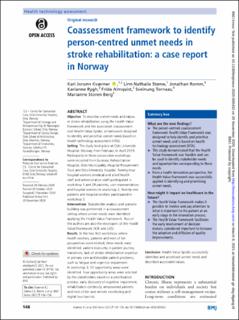| dc.description.abstract | Objective To describe unmet needs and values in stroke rehabilitation using the Health Value Framework and the associated coassessment tool Health Value Spider, a framework designed to identify and prioritise unmet needs based on health technology assessment (HTA).
Setting The study took place at Oslo University Hospital, Norway, from February to April 2019. Participants in three consecutive workshops were recruited from Sunnaas Rehabilitation Hospital, Oslo Municipality, Hospital Procurement Trust and Oslo University Hospital. Twenty-four hospital workers (medical and allied health staff and administrative staff) participated in workshop 1 and 29 patients, user representatives and hospital workers in workshop 2. Twenty-one patients and hospital workers participated in workshop 3.
Interventions Stakeholder analysis and scenario building was performed in a coassessment setting where unmet needs were identified applying the Health Value Framework. Two of the authors are also the developers of the Health Value Framework (KJK and LNS).
Results In the two first workshops where health workers, patients and next of kin perspectives were elicited, three needs were identified: patient insecurity in patient journey transitions, lack of stroke rehabilitation expertise in primary care and invisible patient problems, such as fatigue and cognitive impairment. In workshop 3, 12 opportunity areas were identified. Four opportunity areas were selected by the stakeholders based on a prioritisation process: early discovery of cognitive impairment, rehabilitation continuity, empowered patients and next of kin and remote monitoring and digital touchpoints.
Conclusion Health Value Spider successfully identified and prioritised unmet needs and described associated values. | en_US |

